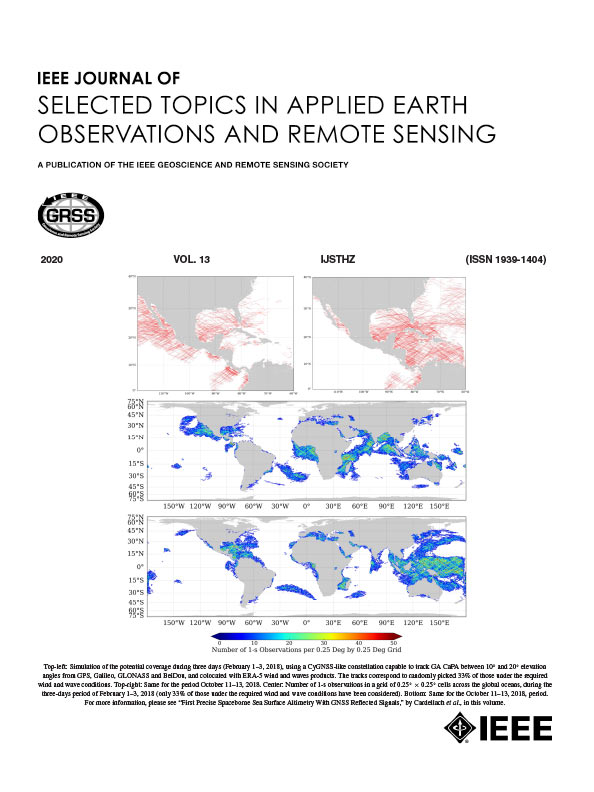基于复值神经网络的多尺度卷积SAR图像目标识别方法
IF 4.7
2区 地球科学
Q1 ENGINEERING, ELECTRICAL & ELECTRONIC
IEEE Journal of Selected Topics in Applied Earth Observations and Remote Sensing
Pub Date : 2025-04-10
DOI:10.1109/JSTARS.2025.3559656
引用次数: 0
摘要
深度学习的最新进展推动了合成孔径雷达(SAR)自动目标识别的重大成功,特别是通过基于卷积神经网络(CNN)的分类算法。然而,由于其独特的成像机制,SAR图像具有独特的物理散射特性。许多深度学习算法仅依赖于幅值信息,而忽略了相位信息,这可能导致原始复值SAR图像中的信息丢失,性能不理想。为了解决这些问题,本文提出了一种基于复值运算的SAR目标识别方法,即复值残差激活和卷积块注意模块(CBAM)网(CRMC-Net)。CRMC-Net有效地利用了复杂值SAR数据中的幅值和相位信息。具体来说,首先,将CNN的元素,包括输入和输出层、卷积层、激活函数和池化层,扩展到复值域。其次,为了进一步增强模型的表示能力,通过不同的卷积核大小提取目标的多尺度信息。最后,网络构造了多个复值操作块,包括复值残差块、复值Mish激活函数和复值CBAM,增强了网络的鲁棒性。在运动和静止目标捕获与识别数据集以及OpenSARShip2.0数据集上的实验结果表明,该网络模型优于传统的实值模型。可以进一步减少分类误差,提高分类性能。本文章由计算机程序翻译,如有差异,请以英文原文为准。
A Multiscale Convolution SAR Image Target Recognition Method Based on Complex-Valued Neural Networks
Recent advances in deep learning have driven significant success in synthetic aperture radar (SAR) automatic target recognition, particularly through convolutional neural network (CNN) based classification algorithms. However, SAR images possess distinctive physical scattering properties, owing to their unique imaging mechanism. Many deep learning algorithms rely solely on amplitude information, ignoring phase information, which may result in the loss of information in the original complex-valued SAR image and suboptimal performance. To tackle these problems, this article introduces a SAR target recognition approach based on complex-valued operations, designated as complex-valued residual mish activation and convolution block attention module (CBAM) net (CRMC-Net). The CRMC-Net effectively utilizes the amplitude and phase information in complex-valued SAR data. Specifically, first, the elements of CNN, including the input and output layers, the convolution layers, the activation functions, and the pooling layers, are extended to the complex-valued domain. Second, in order to further enhance the representation ability of the model, multiscale information of the target is extracted through different convolution kernel sizes. Finally, the network constructs many complex-valued operation blocks to enhance the robustness of the designed network, including the complex-valued residual block, complex-valued Mish activation function, and complex-valued CBAM. The experimental results obtained from the moving and stationary target capture and recognition dataset and OpenSARShip2.0 dataset demonstrate that the proposed network model outperforms the traditional real-valued models. It can further reduce the classification error and enhance performance.
求助全文
通过发布文献求助,成功后即可免费获取论文全文。
去求助
来源期刊
CiteScore
9.30
自引率
10.90%
发文量
563
审稿时长
4.7 months
期刊介绍:
The IEEE Journal of Selected Topics in Applied Earth Observations and Remote Sensing addresses the growing field of applications in Earth observations and remote sensing, and also provides a venue for the rapidly expanding special issues that are being sponsored by the IEEE Geosciences and Remote Sensing Society. The journal draws upon the experience of the highly successful “IEEE Transactions on Geoscience and Remote Sensing” and provide a complementary medium for the wide range of topics in applied earth observations. The ‘Applications’ areas encompasses the societal benefit areas of the Global Earth Observations Systems of Systems (GEOSS) program. Through deliberations over two years, ministers from 50 countries agreed to identify nine areas where Earth observation could positively impact the quality of life and health of their respective countries. Some of these are areas not traditionally addressed in the IEEE context. These include biodiversity, health and climate. Yet it is the skill sets of IEEE members, in areas such as observations, communications, computers, signal processing, standards and ocean engineering, that form the technical underpinnings of GEOSS. Thus, the Journal attracts a broad range of interests that serves both present members in new ways and expands the IEEE visibility into new areas.

 求助内容:
求助内容: 应助结果提醒方式:
应助结果提醒方式:


